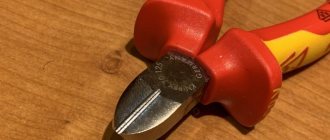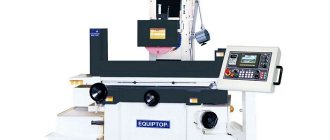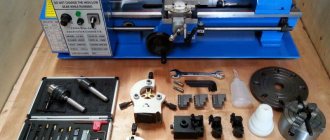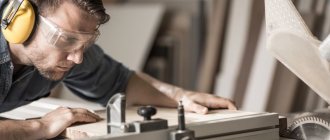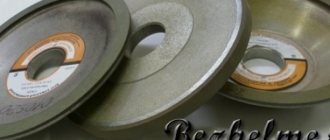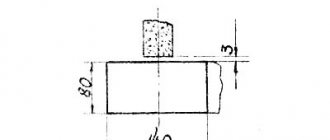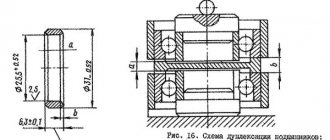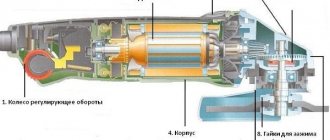Mechanical wear is so merciless that it does not spare even high-strength metal alloys . Over time, the sharpest edges of any cutting tool become dull. It is for this reason that an integral attribute of every more or less serious workshop is a sharpening machine . The review will tell you how to choose a sharpening machine
The basis of a sharpening machine is a grinding wheel, which is made of an abrasive material, most often corundum.
A sharpening machine (electric sharpener) is a device for restoring sharp edges on a cutting tool, all kinds of devices and equipment. An electric sharpener consists of a motor with a grinding wheel attached to its shaft. When a rotating wheel comes into contact with a dull cutting edge, friction occurs .
If you bring the cutting edge at the right angle, then under the influence of friction the abrasive will restore the edge.
The sharpening machine is used for processing:
- Drills, countersinks and reamers
- Knives and cutters
- Chisel, pick and impact bits
- Spatulas and trowels
- Hacksaw blades, saw chains and band saws
- etc.
In fact, the scope of application of sharpening machines is truly limitless . Almost every day some cutting tools and specialized power devices appear that need to be sharpened from time to time. The sharpener will be welcome everywhere, even in a production or repair area, even in the home tool corner.
Types of sharpening machines
Before buying a sharpening device, you should first find out what types of sharpening machines there are and where they should be used. For example, depending on the functionality and scope of application, machines of a universal type and machines of a special type are distinguished.
With the first type, various fasteners and attachments are used, which allows you to expand the scope of application, sharpen and grind a larger number of tools.
Special machines are suitable for working exclusively with workpieces of a certain shape. This limitation is compensated by the fact that a huge number of tools can be processed in a short time.
Productivity is due to the absence of the need to frequently change structural elements. Moreover, their distinguishing feature is the exceptional quality of processed parts. They are good for use in spare parts turning plants.
Among the special purpose machines there are:
- Sharpeners: These are good for working with cutting tools and also for finishing parts. Such machines are good in mechanics' workshops;
- Drill sharpening machines: These are used for grinding twist and feather drills. The main requirement is that the drill diameter should not be more than 18 mm. When using additional equipment, you can change the angle of the plane.
- Disc Saw Machines: Their job is to sharpen the tool and return it to cutting ability. Depending on what abrasive elements are used, you can change the sharpening angle of the working surface;
- Machines for sharpening cutters: process cutters of different shapes;
- Polishing and deburring machines: they are used to remove various defects.
It's difficult to say which sharpening machine is better. It all depends on their functionality and quality of work.
Design and operating principle - necessary basic knowledge
First of all, let's figure out what a sharpening machine is in terms of design and how it works. Externally, this unit is an electric motor hidden behind a steel casing, on both sides of which there are grinding wheels. With a certain technical skill, you can assemble such a machine yourself. During operation, the motor performs rotational movements at a certain speed, forcing the abrasive elements to do the same. To sharpen, you simply need to bring the cutting edge to the sanding equipment and hold the tool in your hands until the required sharpness and smoothness of the metal is achieved.
Before starting the operation, it is advisable to set the sharpening angle recommended by the rules - then the processed object will last much longer!
Always remember the safety rules. Remember to wear personal protective equipment when using sanding equipment (at a minimum, goggles and gloves). Avoid the presence of flammable materials nearby - sparks will form upon contact with metal.
Benefits of using a sharpening machine
Now we should talk about what advantages can be found from using an electromechanical type sharpening machine:
- It is quite possible to do without the help and services of a specialist and restore the cutting properties of a particular tool on your own.
- This device has a fairly long service life of up to 15 years.
- Due to the mechanized process, less time is wasted, which allows you to modernize the work and make it easier.
- This device is quite easy to use, and even an untrained person can handle it.
- Such a machine can be made completely independently.
- Higher productivity and more efficient operation.
Sharpening a chisel or plane knife
A severely worn blade is first re-sharpened on a coarse-grained wheel, and then move on to a finer-grained wheel.
Before sharpening a new bevel on the blade of a chisel or plane, check the cutting edge with a square. If the wear is uneven, use a very fine felt-tip pen to mark a line perpendicular to the sides of the blade. Position the tool rest approximately 3mm from the wheel, make sure it is secure, and turn on the machine while wearing safety glasses.
Dip the blade into the water and, pressing it against the stop with the bevel down, gradually move it in the direction of the circle. Once it reaches the wheel, keep moving the entire width of the edge across the whetstone to prevent overheating. Every few seconds, dip the blade into the water.
Having corrected the perpendicularity, turn off the sharpener and rearrange the stop so that the blade is at an angle of approximately 25° to the circle. Turn on the machine and continue working in the previous manner, now grinding an even bevel across the entire width of the blade. Do not press too hard and cool the blade by regularly dipping it in water or using a special spray, holding the blade with one hand.
If the metal is heated to a temperature that gives it a blue color, it will lose its hardening and will not retain the sharpness of the cutting edge for long. In this case, the only way out is to grind off the blue area of the blade.
Material for machines
The machine body, together with the frame and casings, is made of metal. The protective shields are made of plexiglass.
The disk used to sharpen parts (it is also called the working element) is made solid or coated with a special powder. Emery itself (the material from which abrasive wheels are made) is a type of special granular structure, the elements of which are iron, silicates and crystals.
The grinding wheel can be:
- Diamond: the coating includes a powder from a mixture of carbonates and beads. Diamond is considered one of the strongest materials, and its properties are good for grinding stones, razors and tools made from carbide;
- Vulcanite: This wheel will require vulcanized rubber. It is advisable to add special additives to it to improve its performance properties. Its purpose is to clean and polish metals;
- Felt: discs of this type are good for polishing metal surfaces, because with their help you can achieve a mirror shine. Thick felt is not suitable for working with edges.
The device of a desktop sharpening machine
benchtop grinding machine
The main elements of the machine are the electric motor and the base. The legs are equipped with fasteners to the worktop. On both sides of the electric motor there are abrasive wheels installed parallel to each other. The grain size of the discs is different, one of them is intended for rough turning (coarse-grained), the second is for final finishing.
- The motor in the devices is of the asynchronous type, it operates quite quietly and provides optimal rotation speed;
- abrasive discs can have a diameter from 100 to 250 mm and a thickness from 15 to 32 mm. Often part of the circle is covered with a protective box. The rotation of the vertical disks is carried out in the direction from top to bottom. The most common are electrocorundum and CBN discs;
- the tool rest for supporting the tool being sharpened moves closer or further from the abrasive disc and changes the angle of inclination. The tool rests of universal machines are additionally equipped with grooves for straightening drills;
- The protective screen is installed on professional models and less often on household ones. This is a transparent plastic plate that protects the master from flying sparks;
- The toggle switch for starting and stopping the machine, the speed shift knob are located on the body in a convenient place.
Some sharpeners are equipped with a lamp that illuminates the work area. Others use a wire brush, abrasive bowl, or belt instead of one of the discs.
Sanding sizes
Emery cloths intended for household use are relatively small in size and weigh up to 14 kg. For industrial use, larger machines are used, the weight of which reaches 100 kg by average standards.
The dimensions of such devices directly depend on the size of the electric motors and what maximum permissible disk diameter is permissible for working with a particular machine.
If the dimensions of the machines do not have some common standard, the same cannot be said about the working elements. Since their replacement occurs much more often than replacing the entire machine, therefore, there is no reason to manufacture any unique molds.
Rubber-based abrasive wheels
After the sharpening bevel is formed, the blade is usually polished (straightened) on a whetstone. However, you can straighten chisels and plane knives on a sharpener using neoprene rubber wheels with silicon carbide introduced into it. Wheels with a diameter of 1 00 to 1 50 mm are oil and water resistant and are available in three categories: coarse, medium and fine.
A regular wheel sharpens by rotating toward you, but a rubber-based abrasive wheel must rotate away from you to prevent the blade from damaging the relatively soft material. If your sharpener does not have a reverse and cannot rotate in the opposite direction, you can process the blade on the side of the wheel.
Engine power
Asynchronous motors are used to operate electrical machines. Thanks to their features, it is possible to achieve the ideal balance between acceptable spindle speed and relatively low noise level.
- Speaking about the power of such engines, we can say that elements with a power of up to 1000 W are suitable for domestic use models.
- The most frequently sold models have up to 450 W.
- In industrial environments, motors are used whose power reaches 5 kW.
Spindle speed
The speed of operation directly depends on how many revolutions per minute the spindle makes.
The speed of conventional models reaches three thousand revolutions per minute, provided that there is no contact with any surface.
For some machines, an additional disc is specially installed to allow wet sharpening.
- The lower part of such a circle must be lowered into a container of water.
- The speed of work is noticeably reduced.
- The maximum number of revolutions is less than 150.
Features of tape models
One of the variations of combined models that combine several operational tasks. At a basic level, metal is sharpened using abrasive wheels, and in addition, the designers have provided a shaft that drives the sanding belt. With its help, spot finishing of wooden blanks is carried out. An example of a belt sharpening machine is the Elitech CT 300PC model, which is also equipped with wheel clamps, adjustable supports and a backlight. In this case, the tape provides universal application - not only to wood, but also to plastic and metal. For this type of machine, special belts with a width of 50 mm and a length of 686 mm are produced.
